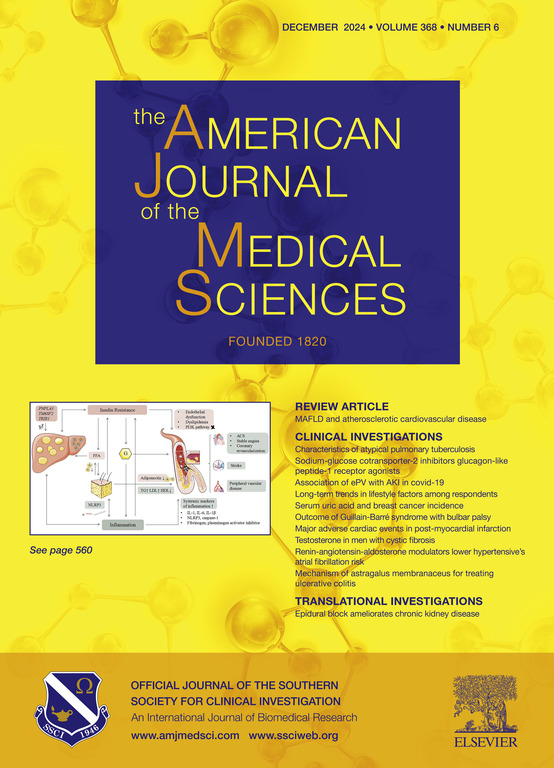Increased prevalence, ER visits, and hospitalizations in medicare systemic lupus erythematosus patients living in socially vulnerable counties: A cross-sectional study
IF 1.8
4区 医学
Q2 MEDICINE, GENERAL & INTERNAL
引用次数: 0
Abstract
Background
Systemic Lupus Erythematosus (SLE) disproportionately affects women, minorities, and individuals with low socioeconomic status. We hypothesized that counties with a higher percentage of disadvantaged individuals have a higher prevalence of SLE and increased acute hospital events, including emergency room (ER) visits and hospitalizations, among Medicare patients with SLE.
Methods
This cross-sectional study used the Centers for Disease Control and Prevention’s Social Vulnerability Index (SVI) and Lupus Research Alliance’s Lupus Index Medicare data. SLE was identified through Medicare fee-for-service administrative records from 2016 containing two or more ICD-10 codes for SLE. We examined SLE prevalence, acute hospital events, and their association with county-level SVI rankings.
Results
The study population was 89 % female and 69 % White, with 22 % Black. SVI ranking (r = 0.508) and its subthemes correlated with SLE prevalence, with socioeconomic status and household composition showing the strongest associations (R = 0.431 and R = 0.365, respectively). Similar but weaker correlations were seen between SVI and acute healthcare events, including ER visits and hospitalizations.
Limitations include the cross-sectional design preventing longitudinal analysis, reliance on administrative data potentially introducing bias, and exclusion of counties with fewer than 10 SLE patients.
Conclusions
This is the first study linking county-level vulnerability to SLE prevalence and healthcare events in a Medicare SLE population. Findings suggest that social and environmental factors influence SLE risk and healthcare utilization, much like other chronic diseases. The modest association between location and hospital/ER events suggests that structural factors may act as barriers to optimal care and outcomes.
生活在社会脆弱县的医保系统性红斑狼疮患者患病率、急诊就诊和住院率增加:一项横断面研究。
背景:系统性红斑狼疮(SLE)不成比例地影响妇女、少数民族和社会经济地位低的个体。我们假设弱势个体比例较高的县SLE患病率较高,急性住院事件增加,包括急诊(ER)就诊和住院治疗,在医疗保险SLE患者中。方法:本横断面研究使用疾病控制和预防中心的社会脆弱性指数(SVI)和狼疮研究联盟的狼疮指数医疗保险数据。SLE是通过包含两个或多个SLE ICD-10代码的2016年医疗保险服务收费管理记录确定的。我们检查了SLE患病率、急性住院事件及其与县级SVI排名的关系。结果:研究人群中女性占89%,白人占69%,黑人占22%。SVI排名(r = 0.508)及其子主题与SLE患病率相关,其中社会经济地位和家庭构成相关性最强(r = 0.431和r = 0.365)。SVI与急性医疗事件(包括急诊室就诊和住院)之间存在类似但较弱的相关性。局限性包括横断面设计不能进行纵向分析,依赖行政数据可能引入偏倚,排除了少于10例SLE患者的县。结论:这是第一个在医疗保险SLE人群中将县级易感性与SLE患病率和医疗事件联系起来的研究。研究结果表明,与其他慢性疾病一样,社会和环境因素影响SLE风险和医疗保健利用。地点与医院/急诊室事件之间的适度关联表明,结构性因素可能成为最佳护理和结果的障碍。
本文章由计算机程序翻译,如有差异,请以英文原文为准。
求助全文
约1分钟内获得全文
求助全文
来源期刊
CiteScore
4.40
自引率
0.00%
发文量
303
审稿时长
1.5 months
期刊介绍:
The American Journal of The Medical Sciences (AJMS), founded in 1820, is the 2nd oldest medical journal in the United States. The AJMS is the official journal of the Southern Society for Clinical Investigation (SSCI). The SSCI is dedicated to the advancement of medical research and the exchange of knowledge, information and ideas. Its members are committed to mentoring future generations of medical investigators and promoting careers in academic medicine. The AJMS publishes, on a monthly basis, peer-reviewed articles in the field of internal medicine and its subspecialties, which include:
Original clinical and basic science investigations
Review articles
Online Images in the Medical Sciences
Special Features Include:
Patient-Centered Focused Reviews
History of Medicine
The Science of Medical Education.

 求助内容:
求助内容: 应助结果提醒方式:
应助结果提醒方式:


